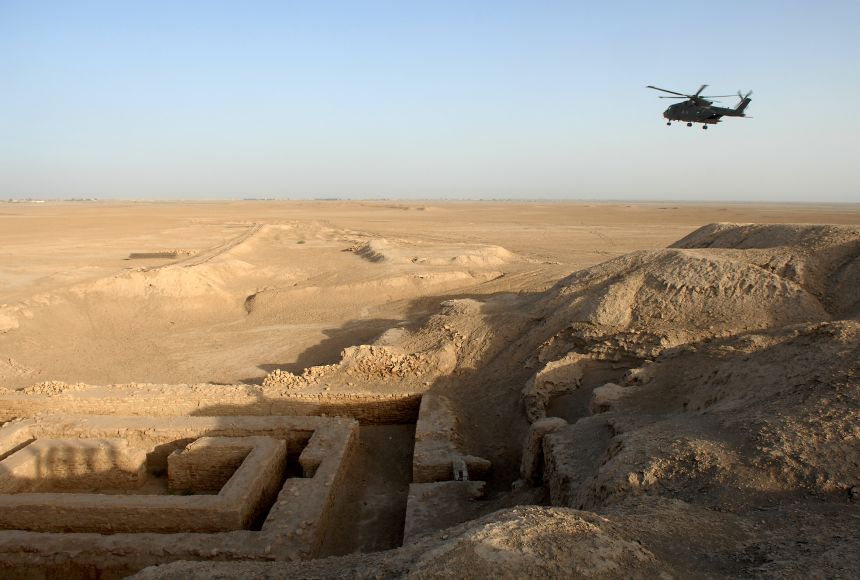The first cities appeared thousands of years ago, built in places where the land was rich and fertile. Cities such as Eridu, Uruk, and Ur were founded in Mesopotamia around 7500 B.C.E. They were just a few of the many communities between the Euphrates and Tigris rivers, an area called the Fertile Crescent. Cities also formed along the Nile River in Egypt, the Indus River Valley on the Indian subcontinent, and the Huang (or Yellow) River in China. These communities began to grow crops, and their success as farmers meant that they could give up their wandering lifestyle as hunters and gatherers to take advantage of food surpluses. Nearby waterways also provided a much-needed transportation system and made it possible to engage in trade.
For the next several thousands of years, cities continued to grow in number, size, and importance. Some of the world's largest cities have grown steadily for hundreds of years, while others have suddenly blossomed. Some of the cities that were once among the most populous in the world, like the largest cities of Mesopotamia, no longer exist, and others have experienced a decline in population. For instance, in the first century B.C.E., the city of Rome topped one million people, making it the largest city in Europe, but its population declined to just 20,000 during the Middle Ages.
These are exceptions, however. Most of the world's cities continue to grow, and some are growing faster than ever before. In fact, in 2017, the population of Rome was nearly three million.
People Left Rural Areas for Big Cities
Throughout history, people have been drawn to cities as centers of trade, culture, education, and economic opportunity. Until recent years, though, the vast majority of people lived in the countryside. In 1800, for instance, more than 90 percent of the global population lived in rural areas, with more than 94 percent living in the country in the United States. By 1900, however, only 60 percent of Americans lived in rural areas. This trend has only continued, with huge waves of people moving from rural areas to cities in the modern era.
One of the main reasons for the growth of cities was the Industrial Revolution, which began in England toward the middle of the 18th century and spread to the United States and other parts of Europe. During the Industrial Revolution, thousands of factories were built in cities, creating a demand for workers there. Over the next century, millions of people in the United States and England moved from farms to cities, and as other parts of the world industrialized, more cities expanded.
Thanks in part to the Industrial Revolution, London grew from a population of one million in 1800 to over six million a decade later. Growth continued for the next two centuries, and by 1950, New York City, New York, U.S., was the largest metropolitan area in the world, with a population of 12.5 million.
The growth of cities has also been fueled by new technologies, most notably technologies allowing cities to grow upward. The invention of steel, a new and extremely strong kind of metal, gave birth to the skyscraper">skyscraper, which allowed many more people to live and work within a city's limits. The invention of the elevator made it possible for these skyscrapers to take people up to their apartments and offices in the sky.
The Rise of the Megacity
Experts say over half the world's population today lives in cities and that around two-thirds of people will be living in cities by 2050. Much of this growth will be the result of families in cities having more children, but it will also be driven by the continued migration of people from rural areas to cities.
All this growth has led to a new type of city: the megacity, which is defined as having a population of 10 million or more. The metropolitan areas of New York City and Tokyo, Japan, became the world's first megacities in the 1950s, and by 2018, there were 37 megacities across the globe. While the largest cities of the Industrial Revolution existed in North America and Europe, today it is cities in Asia and Africa that are experiencing the fastest growth due to industrialization. As of 2019, Tokyo, with more than 37 million metropolitan area residents, is the world's largest city. Delhi, in India, has almost 30 million residents, and Shanghai, China; Mexico City, Mexico; and São Paulo, Brazil, all have metropolitan area populations well over 20 million.
Some Cities Struggle to Provide Services
The United Nations has predicted that there will be 41 megacities by the year 2030. India, which already has five cities with metropolitan areas with over 10 million residents, is expected to have seven by 2030. Some megacities may be in places that surprise you, such as Kinshasa, the capital of the Democratic Republic of the Congo. Already a megacity with a population of 11.6 million, Kinshasa may quickly outgrow some of the world's largest cities.
Just as rapidly growing cities in England and North America struggled to keep up with the population growth in the industrial era, cities in Africa and Asia are also struggling to provide services to rapidly growing populations. Lagos, Nigeria, the largest city in Africa, is home to 12.6 million people. About two-thirds of them live in slums, overcrowded neighborhoods where people live in poor and dangerous conditions. The rise of slums is one of the negative effects of the speed with which cities have grown. Despite such downsides, the population in the world's megacities continues to grow, and will likely keep growing for years to come.
